Puerto Rico Fieldwork Experiences
Tanner Shull Bio

Tanner Shull is an MPH student in the Division of Epidemiology and Biostatistics enrolled in the Global Health Program. Tanner is conducting his applied practice experience in San Juan, Puerto Rico at the Comprehensive Cancer Center of Puerto Rico (Centro Comprehensivo de Cáncer). Tanner will be studying oropharyngeal cancer and other oral hygiene outcomes among people living with HIV (PLWH) and concomitant HPV infection. Through this experience, Tanner will describe epidemiological trends of infection, cancer, and their social and biological determinants.
Tanner Shull Blog
Tanner Shull Blog
Bienvenidos a la Isla del Encanto –
I can’t remember what my official welcome was first to Puerto Rico: the humidity or the cackle of the Antillean grackle. For the past two weeks in San Juan, both have been an ever-present part of my experience so far. Within the closed buildings of the Comprehensive Cancer Center, however, both are pushed aside as I work.
For my applied practice experience, I am a graduate researcher in a Cancer Prevention and Control Program (CAPAC). I’m joined by 25 other dedicated graduate, medical, and pharmacy students for a 10-week internship at the Comprehensive Cancer Center of Puerto Rico in San Juan. Each of us brings unique research questions and previous experiences in research. This summer, we are applying them to cancer and its social and biological determinants.
My specific project will include analyzing the social determinants of oropharyngeal cancers among people living with HIV. This cohort has also undergone dental evaluations, and their samples will be analyzed for high-risk HPV strains, which have been found to increase the odds of cancer development. Additionally, the bacteria in their mouth will be sequenced and used to determine any contributions specific bacteria have in their carcinogenesis. I am assisting the laboratory in recruiting participants and collecting their samples by spending time in a free community STI clinic called PR CoNCRA in the Río Piedras neighborhood of San Juan.
Every Friday, we have seminars on cancers in Puerto Rico, current research and perspectives, and professional development. Together, we learn more about the Puerto Rican context of cancer, health care, and how we can contribute to its improvement in the future as health care professionals. For example, incidence of oropharyngeal cancers in both men and women are increasing in Puerto Rico and in the United States. Further, Puerto Rico has the highest incidence of HPV among unvaccinated females in the United States – which contributes to the development of HPV-driven cervical cancers (Ortiz et al, 2018). This same phenomenon is thought to be responsible for the increasing incidence of oropharyngeal cancers among both men and women (D’Souza et al, 2017; Pytynia et al, 2014; SEER, 2022).
Empanadilla vs pastelillo –
The best part of going abroad for my applied practice experience is the ability to learn more about the culture and people of Puerto Rico. To that end, I have been overwhelmed by their hospitality, genuine willingness to talk, and pride in their communities and island.
One of the best ways to learn about culture is through food. So far, I have tried traditional Puerto Rico cuisine such as mofongo, amarillos, quesitos, and empanadillas. An instant conversation starter here is asking the difference between an empanadilla and a pastelillo. They are not the same – and I have concluded the only way to understand the delicate nuance that sets the two apart is by posing the question in a group and then instantly stepping back and absorbing the ensuing argument.
In the coming weeks, I have a long list of destinations and activities I have heard are essential for my summer here: a visit to El Yunque National Park, playing beach tennis, and traveling to both the beaches on the east and west of the island. Along the way, I am excited to continue my research, form bonds with the other program participants, and learn more about the culture and passions that are as unique as Puerto Rico itself.
Tanner Shull Blog
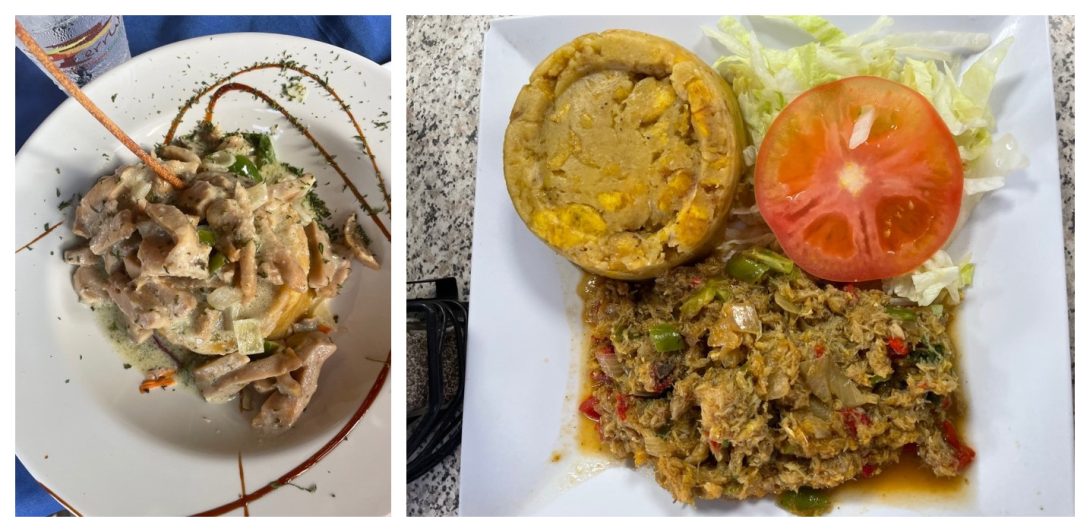
Mofongo is a traditional Puerto Rican dish that serves as the main course with an accompaniment of protein/meat and a sauce. Mofongo here is made from green plantains that are cut and fried before being mashed together. It is a nutrient rich absorbent of flavors and foods that it is served with. In the photo on the left, I had a mofongo with garlic sauce and the meat from conch (carrucho). In the photo on the right, I had mofongo with crab gazpacho.
Tanner Shull Blog

Above is a pastellilo with rabbit meat. Generally, the difference between a pastelillo and empanadilla is that an empanadilla is a more traditional “turnover,” whereas the pastelillo has edges that are formed by fork presses (like the above). Both can be sweet or savory and sometimes, pastelillos are baked while empanadillas are fried
Tanner Shull Blog

This is the CAPAC Class of 2022. We are 25 students across the United States and Puerto Rico from graduate fields in public health, medicine, and pharmacy. Here, we had a team building day at the San Juan Lagoon that included team building activities and kayaking.
Tanner Shull Blog

Uncovering Cancer Clues –
After getting familiar with the lab, I started processing some samples from the recruited participants. Before, I had mentioned how we were looking at markers that increase the risk of cancers. Within the mouth, these include bacterial markers and their products such as lipopolysaccharide (LPS) and transforming growth factor (TGFb1). LPS is found in the cell walls of gram-negative bacteria and TGFb1 drives tumor formation when it is highly expressed. Because both will always be found in human samples, what we are concerned with is how much. Too much TGFb1 points to pre-cancerous epithelial lesions because it tips the balance between growth and division to uncontrollable levels. Too much LPS activates our immune system aimlessly and without direction. As a result, it’s easier for cancer cells to go undetected.
Our first samples showed significantly elevated TGFb1 and LPS in the plasma of people living with HIV (PLWH) compared to those without HIV (PWOH). Analyzing these levels through the lens of HIV helps us learn how even controlled HIV infection can still increase risk for adverse health events. Among PLWH, for example, their average TGFb1 levels were nearly 3 times higher than PWOH (Figure 1). Their levels of LPS were twice the level of PWOH (Figure 2).
As an epidemiology student, I run different statistical tests to explain these findings. In this way, I can rule out different variables that may contribute to this difference between HIV status (called “confounders”) or directly get in the way of our results (called “effect modifiers” or “mediators”). We almost always look at gender, age, race and ethnicity, and other clinical characteristics to explain our results. Among the first tests I ran with those variables, however, nothing seemed to explain it. As a result, we can be more confident it is more driven by the biological consequences of living with HIV instead of other variables.
In the coming weeks, I will expand my samples to include their saliva and another immune activation marker called soluble CD14. I will continue to look at social characteristics and health access to potentially explain these findings and their potential to lead to cancer.
Tanner Shull blog
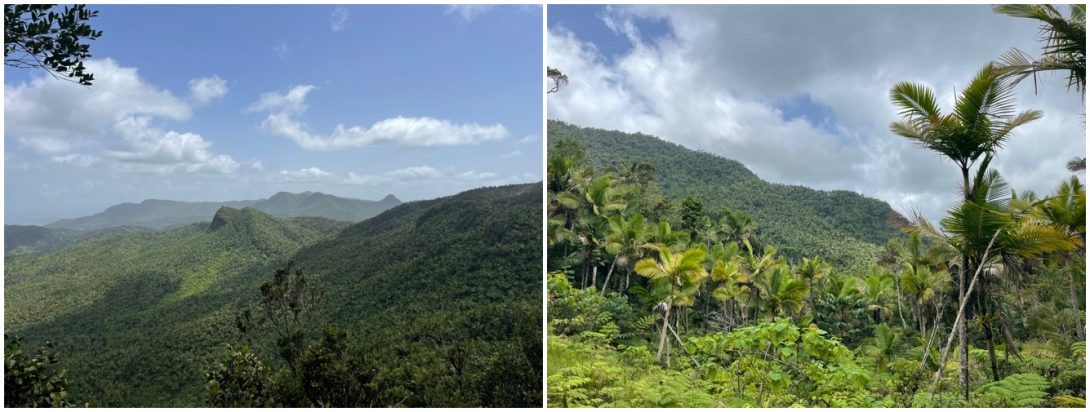
El Yunque National Forest –
As promised, I visited the only tropical rain forest in the United States: El Yunque National Forest. Interestingly, El Yunque is one of the smallest national forests in the United States but contains the most biologically diverse ecosystems (Forest Service & USDA, 2022). It has been an officially protected land since 1876 and has gone through varying name changes since, including Luquillo Forest Reserve, Caribbean National Forest, and finally El Yunque. Its current namesake was influenced by the indigenous Taíno name for its tallest peak “Yuke” and deity “Yúcahu.” Yúcahu represents agriculture, peace, tranquility, and fertility (Shelley, 2020).
I was most excited to visit El Yunque for its biological diversity. It is home to nearly 130 species of vertebrates, 240 tree species, and even 50 native orchid species (Shelley, 2020). I got to hear the Puerto Rican national tree frog nearly 8 years after our high school Spanish class on the subject. Their name itself is an onomatopoeia: coquí sounds exactly like the noise they make (audio here).
We hiked nearly 2.5 miles to reach los Picachos, which was an overlook of the forest. Much of El Yunque is still damaged and being repaired after Hurricane María in 2017. For that, we could not hike to its namesake peak, which is nearly 3,500 feet above sea level.
Tanner Shull blog
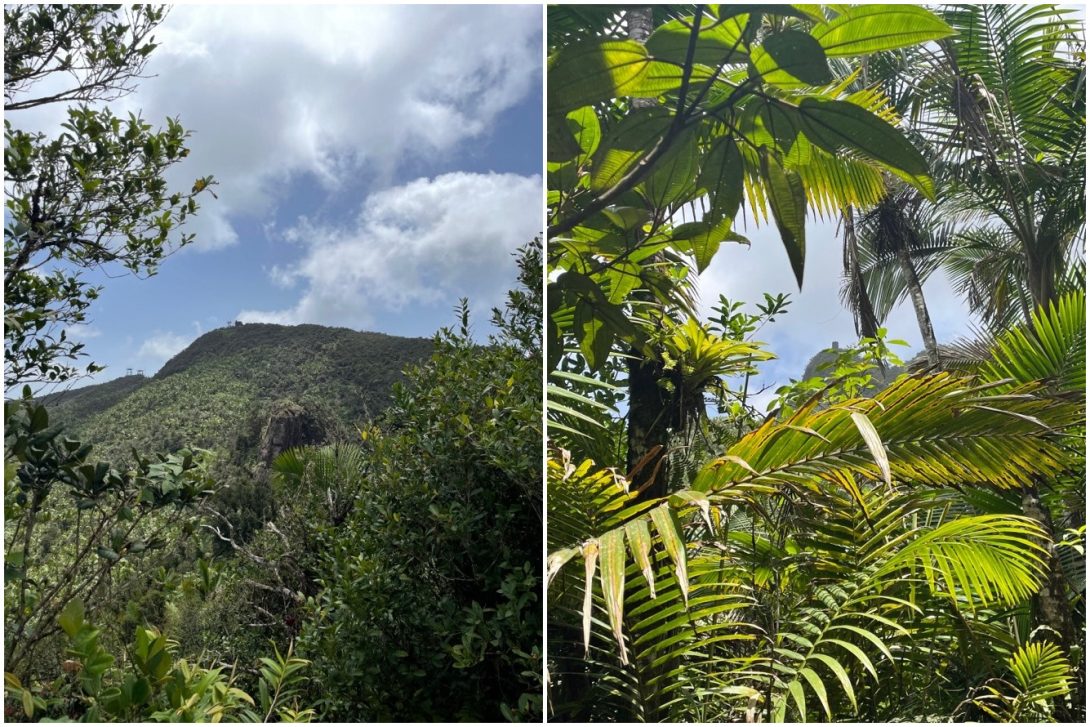
The view from Los Picachos overlook (left). You can see the top of the Mount Yunque directly ahead. In the right, there is Mount Britton, which is also visible from the trail.
Tanner Shull Blog
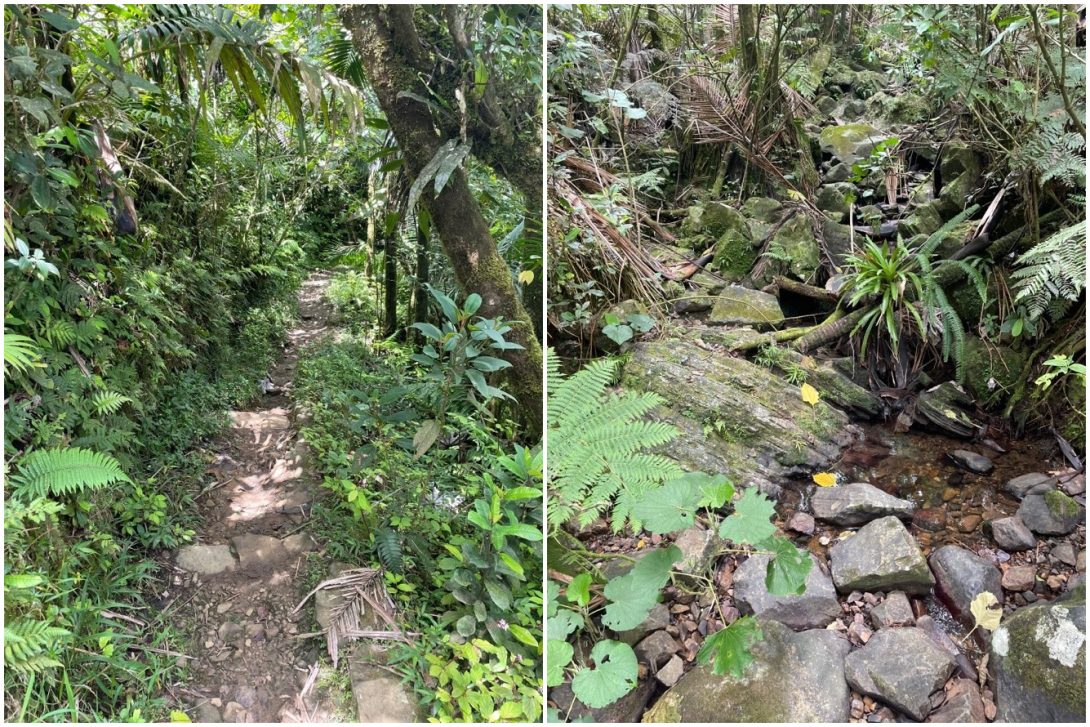
Views from the trail (left) and one of the many freshwater streams in El Yunque (right). The rain forest provides nearly 20% of all fresh water to the island.
Tanner Shull Blog
Finding the balance –
Between work, the beach, and the mountains of El Yunque, I have been challenged to find time for everything I want to do during my short time here. A simple step outside in the sun and blue skies might end up at the beach to enjoy a sunset. I have been fortunate to get to know the program participants better through cultural events like La Noche de San Juan, the National Hammock Festival, and more.
Tanner Shull Blog
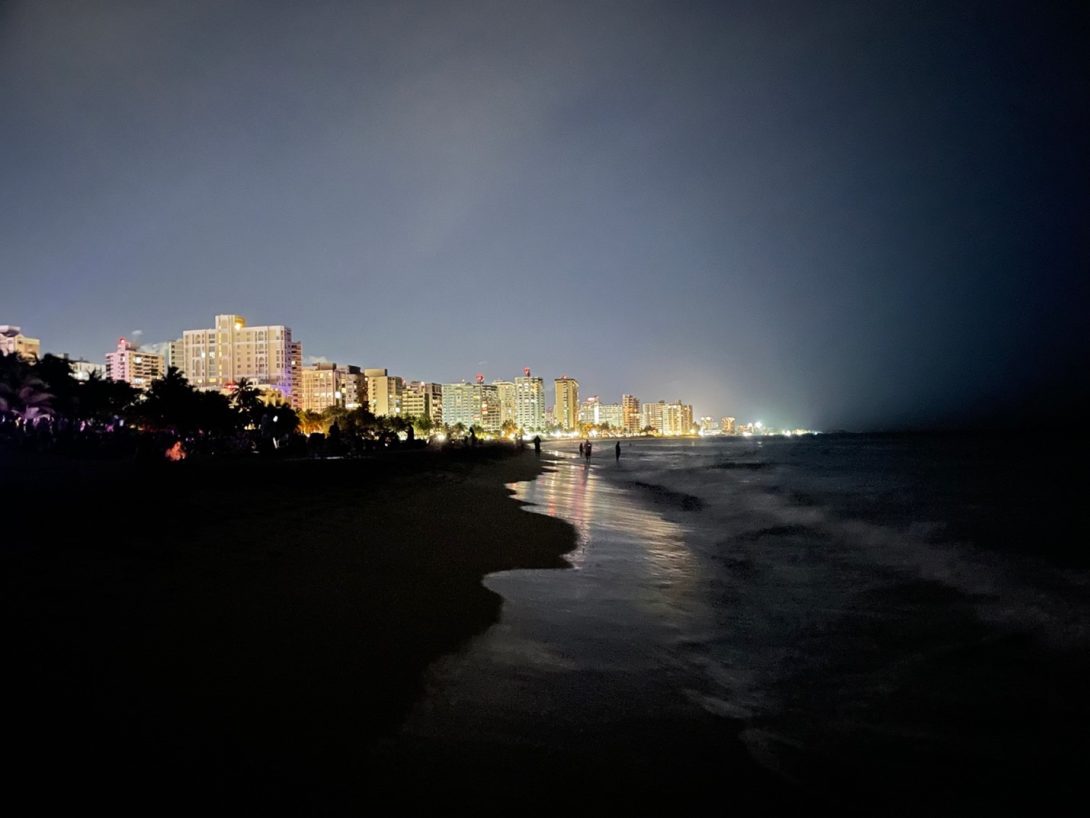
During la Noche de San Juan, people will find any beach and dunk themselves backwards 3-12 times to rid all the negativity and manifest positivity in the coming year. It is celebrated at midnight of June 23 for John the Baptist’s birthday (June 24). I could not get a better picture, but all of us at Ocean Park beach ran into the water at the stroke of midnight.
Tanner Shull Blog
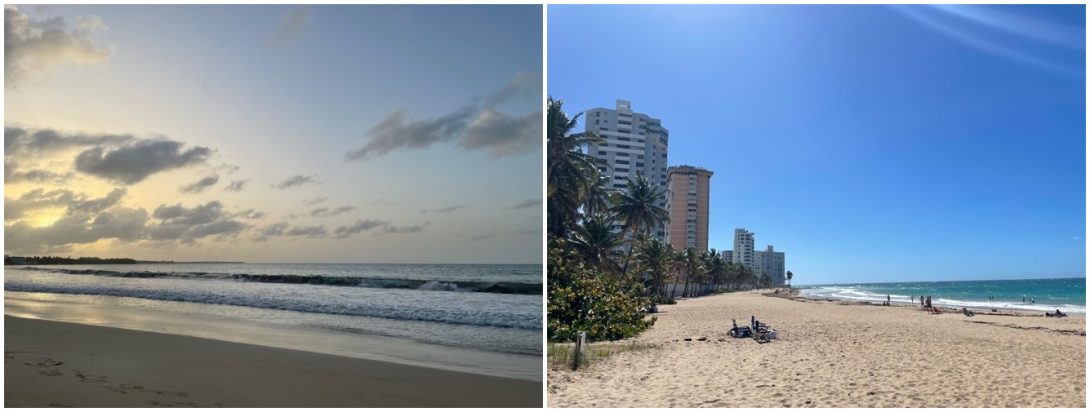
A sunset at the Luquillo beach (left) and clear sky day at the Condado beach (right).